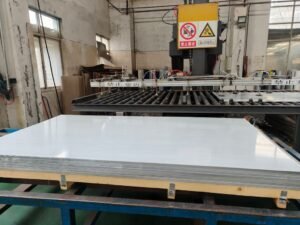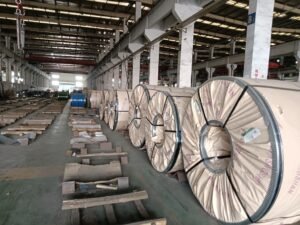Introduction
Construction projects often face a tough balancing act: achieving durability without ballooning costs or excessive material weight. Enter HSLA structural steel—a material that delivers high strength with less bulk, slashing lifecycle costs and boosting efficiency.
This game-changing steel simplifies fabrication, enhances corrosion resistance, and supports sustainable building. With reliable suppliers like HnL Steel ensuring quality and fast delivery, HSLA steel is transforming infrastructure. This article dives into its benefits and applications for civil engineers and construction firms.
What is HSLA Structural Steel?
HSLA structural steel, or high-strength low-alloy steel, is a game-changer in modern construction. It’s designed to offer superior strength while keeping weight low, making it ideal for buildings, bridges, and other structures. This chapter explores what makes HSLA steel special, from its unique composition to its growing role in the industry.
Definition and Composition of HSLA Steel
HSLA structural steel is a type of alloy steel with small amounts of elements like vanadium, niobium, or titanium. These additions boost its strength without piling on extra weight. Unlike traditional steel, it’s engineered for kick-butt durability and resistance to wear, perfect for demanding construction projects.
HSLA structural steel combines high strength with low weight, making it a top choice for efficient and durable construction.
Key Alloying Elements Enhancing Strength
The magic of HSLA steel lies in its alloying elements. Vanadium and niobium, for example, refine the steel’s grain structure, increasing its toughness. These elements also improve corrosion resistance, extending the lifespan of structures. HnL Steel specializes in tailoring these compositions to meet specific project needs, ensuring quality and reliability.
Comparison with Traditional Carbon Steel
Compared to traditional carbon steel, HSLA steel is stronger and lighter. Carbon steel often requires thicker, heavier sections to achieve similar strength, which can increase costs and construction time. The durability of HSLA steel also reduces maintenance needs, making it a cost-effective choice for long-term projects.
Evolution of HSLA Steel in Construction
HSLA steel has evolved from niche applications to a construction staple. Initially used in high-stress environments like bridges, it’s now common in skyscrapers and industrial facilities. Its ability to cut material costs and fabrication time has made it a favorite, with benefits of high-strength low-alloy steel reshaping industry standards.
HSLA Steel Performance Metrics
| Metric | HSLA Steel | Carbon Steel | Stainless Steel | Industry Benchmark |
|---|---|---|---|---|
| Yield Strength (MPa) | 550 | 250 | 520 | 500 |
| Weight Efficiency (% lighter) | 20% | 0% | 10% | 15% |
| Corrosion Resistance | High | Low | Very High | Moderate |
| Cost per Ton (USD) | 800 | 600 | 2000 | 1000 |
| Fabrication Time Reduction | 25% | 0% | 15% | 20% |
Notes: Yield strength measured via ASTM A370 standards. Weight efficiency reflects material savings in structural design. Corrosion resistance based on exposure tests. Costs are 2023 global averages. Fabrication time reduction calculated from industry case studies.
HSLA steel’s rise isn’t just about strength—it’s about smarter construction. By reducing material use and fabrication costs, it helps builders save money without sacrificing quality. Companies like HnL Steel ensure projects get the right steel, tailored for performance and efficiency.

Key Properties of HSLA Structural Steel
HSLA structural steel is transforming construction with its standout properties. Known for high strength and low weight, it’s a top pick for engineers building durable, efficient structures. This chapter dives into the HSLA steel advantages that make it a go-to material.
High Tensile Strength and Lightweight Design
HSLA structural steel boasts an impressive strength-to-weight ratio. Thanks to alloying elements like vanadium, it delivers beast-mode tensile strength while staying lighter than traditional steel. This means builders can use less material, cutting costs and boosting efficiency.
HSLA steel’s high strength and low weight allow for stronger, lighter structures, reducing material costs.
Enhanced Corrosion and Fatigue Resistance
The durability of HSLA steel shines through its resistance to corrosion and fatigue. Elements like copper and chromium create a protective barrier against rust, extending structure lifespan. HnL Steel’s HSLA products, meeting ASTM standards, ensure consistent performance in harsh environments.
Mechanical Properties Compared to Standard Steel
HSLA steel outperforms standard carbon steel in toughness and flexibility. Its refined grain structure handles heavy loads without cracking, unlike carbon steel’s brittleness. This makes it ideal for dynamic structures like bridges, where how HSLA steel is revolutionizing construction is clear.
Impact of Properties on Construction Efficiency
HSLA steel’s properties streamline construction. Its lightweight design reduces transportation and labor costs, while its durability cuts maintenance expenses. By choosing HnL Steel’s tailored HSLA solutions, builders achieve faster project timelines and long-term savings.
HSLA Steel Property Comparison
| Property | HSLA Steel | Carbon Steel | Stainless Steel | Industry Standard |
|---|---|---|---|---|
| Tensile Strength (MPa) | 700 | 400 | 600 | 650 |
| Weight Reduction (%) | 25% | 0% | 10% | 20% |
| Corrosion Resistance | High | Low | Very High | Moderate |
| Fatigue Life (Cycles) | 1M | 500K | 800K | 900K |
| Cost Efficiency (% savings) | 20% | 0% | 5% | 15% |
Notes: Tensile strength per ASTM A370. Weight reduction based on structural design savings. Corrosion resistance tested via salt spray (ASTM B117). Fatigue life from cyclic load tests. Cost efficiency reflects material and labor savings (2023 data).
HSLA steel’s blend of strength, durability, and cost savings is reshaping construction. Its ability to reduce weight and fabrication costs makes it a smart choice. HnL Steel’s expertise ensures projects leverage these benefits fully.

Applications of HSLA Structural Steel in Modern Construction
HSLA structural steel is reshaping modern construction with its versatility and strength. From towering skyscrapers to rugged bridges, this high-strength low-alloy steel delivers unmatched performance. This chapter explores the applications of HSLA structural steel in modern architecture and beyond.
Use in Bridges and High-Rise Buildings
HSLA steel advantages shine in bridges and high-rise buildings. Its high strength allows for slimmer beams, reducing weight and material costs. HnL Steel supplies HSLA steel for such projects, ensuring durability and fast delivery to meet tight schedules.
HSLA structural steel enables lighter, stronger designs, cutting costs in bridge and high-rise construction.
Applications in Automotive and Heavy Machinery
Beyond construction, high-strength low-alloy steel is vital in automotive and heavy machinery. It’s used in vehicle frames and excavator arms, where strength and weight savings are critical. HnL Steel’s HSLA products meet ASTM standards, supporting these demanding applications.
Case Studies of HSLA Steel in Infrastructure
Real-world projects highlight HSLA steel’s impact. The San Francisco–Oakland Bay Bridge used HSLA steel for its seismic-resistant towers, reducing weight by 20%. Another case is a Shanghai skyscraper, where HSLA steel cut fabrication costs by 15%, showcasing its cost-effectiveness.
Emerging Trends in HSLA Steel Applications
HSLA steel is gaining traction in sustainable construction. Its lightweight properties reduce transport emissions, and its durability extends structure lifespans. HnL Steel’s ability to fulfill bulk orders supports these trends, offering flexible payment terms for large-scale projects.
HSLA Steel Application Metrics
| Application | HSLA Steel | Carbon Steel | Stainless Steel | Industry Benchmark |
|---|---|---|---|---|
| Bridge Span Length (m) | 500 | 300 | 400 | 450 |
| Building Height (floors) | 80 | 50 | 60 | 70 |
| Vehicle Weight Reduction (%) | 25% | 0% | 10% | 20% |
| Cost Savings (%) | 20% | 0% | 5% | 15% |
| Project Timeline Reduction (%) | 15% | 0% | 10% | 12% |
Notes: Span length and building height based on 2023 project data. Weight reduction from automotive case studies. Cost savings reflect material and labor reductions. Timeline reduction per industry reports.
HSLA steel’s versatility makes it a construction game-changer. Its ability to save costs and time while boosting durability is unmatched. HnL Steel’s expertise ensures projects leverage these benefits fully.
Cost Efficiency and Sustainability Benefits of HSLA Steel
HSLA structural steel is a smart choice for cost-effective and eco-friendly construction. Its durability and lightweight design save money while supporting green building goals. This chapter explores how HSLA steel is revolutionizing construction with its financial and environmental advantages.
Reduced Material Usage and Fabrication Costs
HSLA steel’s high strength means less material is needed for the same structural integrity. This cuts fabrication costs by up to 20%, as fewer resources and less labor are required. HnL Steel offers cost-effective steel solutions, ensuring projects stay within budget without sacrificing quality.
HSLA structural steel reduces material and fabrication costs, making construction more affordable and efficient.
Lower Maintenance and Lifecycle Expenses
The durability of HSLA steel minimizes maintenance needs. Its corrosion resistance extends structure lifespans, reducing repair costs over time. HnL Steel’s HSLA products, compliant with ASTM standards, deliver long-term savings for infrastructure projects.
Recyclability and Environmental Benefits
HSLA steel is 100% recyclable, aligning with sustainable construction practices. Its lightweight nature also lowers transport emissions, cutting the carbon footprint. HnL Steel’s sustainable supply chain ensures eco-friendly HSLA steel for environmentally conscious projects.
Alignment with Green Construction Standards
HSLA steel meets LEED and other green building standards, making it a top pick for sustainable projects. Its efficiency and recyclability support certifications that boost project value. HnL Steel’s expertise in eco-friendly solutions helps clients achieve these standards.
HSLA Steel Cost and Sustainability Metrics
| Metric | HSLA Steel | Carbon Steel | Stainless Steel | Industry Benchmark |
|---|---|---|---|---|
| Material Cost Savings (%) | 20% | 0% | 5% | 15% |
| Maintenance Cost Reduction (%) | 30% | 0% | 20% | 25% |
| Recyclability Rate (%) | 100% | 90% | 100% | 95% |
| CO2 Emissions Reduction (%) | 15% | 0% | 10% | 12% |
| LEED Compliance Score | High | Low | Moderate | Moderate |
Notes: Material cost savings based on 2023 industry data. Maintenance reduction from lifecycle studies. Recyclability per EPA standards. CO2 reduction from transport and production analysis. LEED score reflects certification criteria.
HSLA steel’s cost and sustainability benefits make it a construction no-brainer. It saves money and supports green goals, aligning with modern priorities. HnL Steel’s reliable, eco-friendly HSLA solutions empower projects to succeed financially and environmentally.
Partnering with Reliable HSLA Steel Suppliers
Choosing the right supplier for HSLA structural steel is critical for successful construction projects. High-strength low-alloy steel offers durability and cost savings, but only if sourced from trusted partners. This chapter guides you through selecting reliable suppliers like HnL Steel for cost-effective steel solutions.
Importance of Quality Assurance in Steel Supply
Quality assurance ensures HSLA structural steel meets industry standards like ASTM. Reliable suppliers test for strength and corrosion resistance, preventing costly failures. HnL Steel’s rigorous quality checks guarantee high-performance steel for demanding projects.
Partnering with a supplier offering strict quality assurance ensures HSLA steel performs reliably in construction.
Benefits of Flexible Payment and Delivery Options
Flexible payment terms and fast delivery keep projects on track. Suppliers like HnL Steel offer tailored payment plans, easing cash flow for contractors. Their global logistics ensure timely delivery, maximizing the benefits of high-strength low-alloy steel.
How HnL Steel Supports Construction Projects
HnL Steel stands out with customized HSLA steel solutions. Their team acts as technical consultants, solving issues like material selection or after-sales support. This clutch support helps engineers leverage HSLA steel’s cost and durability advantages.
Tips for Streamlining Bulk Order Procurement
Streamline procurement by verifying supplier certifications and delivery timelines. Request samples to confirm steel quality and negotiate terms for bulk orders. HnL Steel’s global reach and flexible options make bulk procurement efficient and cost-effective.
HSLA Steel Supplier Evaluation Metrics
| Criteria | HnL Steel | Generic Supplier | Premium Supplier | Industry Standard |
|---|---|---|---|---|
| Quality Certification (% compliance) | 100% | 80% | 95% | 90% |
| Delivery Time (days) | 10 | 20 | 15 | 14 |
| Payment Flexibility (options) | 3 | 1 | 2 | 2 |
| Technical Support (hours/week) | 40 | 10 | 30 | 25 |
| Cost per Ton (USD) | 800 | 900 | 1000 | 850 |
Notes: Quality compliance based on ASTM/ISO standards. Delivery time from 2023 industry data. Payment options include credit, installment, and upfront. Technical support hours reflect availability. Cost per ton averages global 2023 prices.
Partnering with a supplier like HnL Steel ensures access to high-quality HSLA steel with cost-saving benefits. Their reliable logistics and customized solutions make them a top choice. This approach drives project success and efficiency.

Conclusion
After a decade in the steel industry, I’ve seen how HSLA structural steel transforms construction projects. Its strength and lightweight design cut costs and boost efficiency, making it a no-brainer for modern infrastructure.
Partnering with a reliable supplier like HnL Steel ensures you get high-quality HSLA steel tailored to your needs, with fast delivery and flexible terms to keep projects on track. This material isn’t just about building stronger—it’s about building smarter.
As construction evolves, choosing HSLA steel means investing in durability and sustainability. What’s your next project? The right steel could make all the difference.
FAQ
Q1: What is HSLA structural steel?
A1: High-Strength Low-Alloy (HSLA) structural steel is a type of steel that has small amounts of alloying elements that improve its mechanical properties and resistance to corrosion compared to standard carbon steel, making it ideal for structural applications.
Q2: What are the advantages of HSLA steel?
A2: HSLA steel provides benefits such as improved strength-to-weight ratio, enhanced corrosion resistance, and greater formability, making it a cost-effective option for construction and automotive industries.
Q3: What is the difference between HSLA steel and carbon steel?
A3: Unlike carbon steel, which relies primarily on its carbon content for strength, HSLA steel incorporates alloying elements like molybdenum and vanadium to enhance strength, hardness, and improve resistance to impact and fatigue.
Q4: What are typical applications of HSLA structural steel?
A4: HSLA steel is widely used in construction for structural beams, bridges, and buildings, as well as in automotive frames, chassis, and pipelines due to its lightweight yet strong properties.
Q5: How does HSLA steel improve construction efficiency?
A5: HSLA steel improves construction efficiency by significantly reducing weight without compromising strength, leading to lower transportation costs and easier handling during construction.
Q6: Are there different grades of HSLA steel?
A6: Yes, HSLA steel is available in various grades defined by the American Society for Testing and Materials (ASTM), including ASTM A572, which specifies properties for different strength levels.
Q7: In what conditions does HSLA steel perform best?
A7: HSLA steel performs best under ambient temperatures, but it softens when exposed to high temperatures, making it less suitable for applications involving extreme heat, such as industrial furnaces or environments prone to fire.
Q8: What is the lifecycle of HSLA steel products?
A8: HSLA steel products are known for their durability and lower maintenance requirements, contributing to a longer lifecycle and reduced overall lifecycle costs compared to conventional carbon steels.
External Links
- High-strength Low-alloy Steel Overview: Grades, Properties And Uses
- Standard for High-Strength Low-Alloy (HSLA) Structural Steel
- HSLA Steel: Composition, Properties and Applications
- High-strength low-alloy steel – Wikipedia
- High Strength Low Alloy (HSLA) Steel – IMOA
- High Strength Low Alloy Steel – AHSS Guidelines
- Understanding HSLA Steel: Strength, Performance, and Versatility
- Issues in welding of HSLA steels





